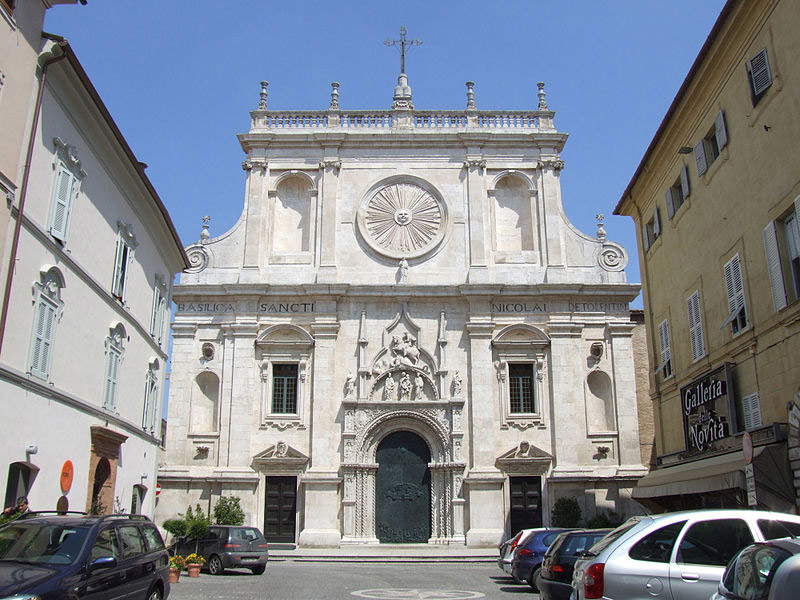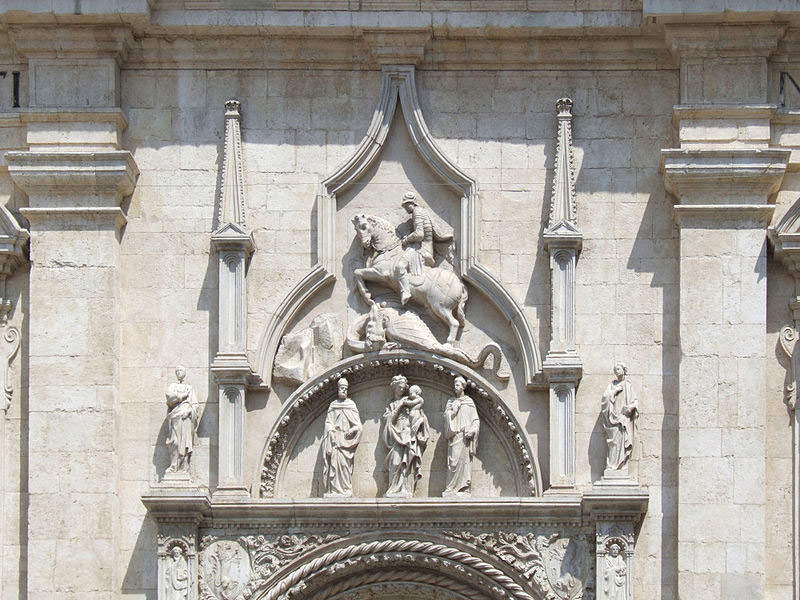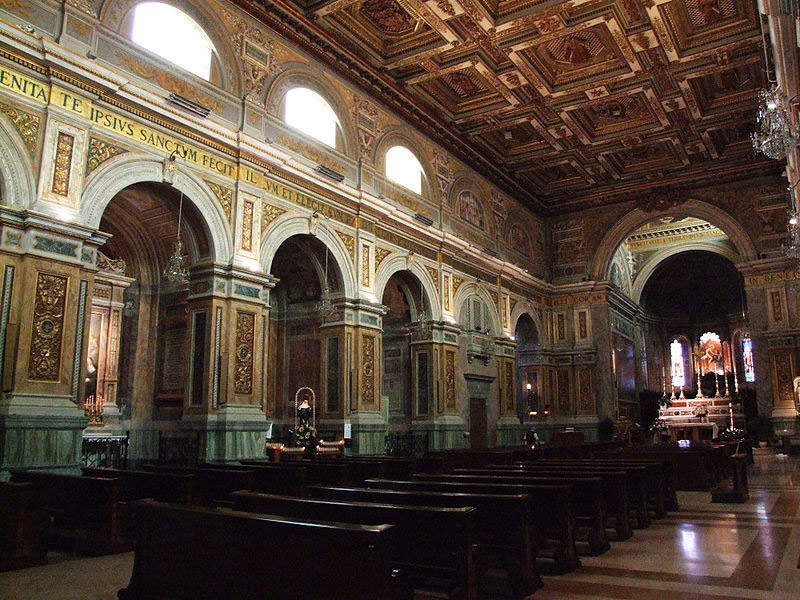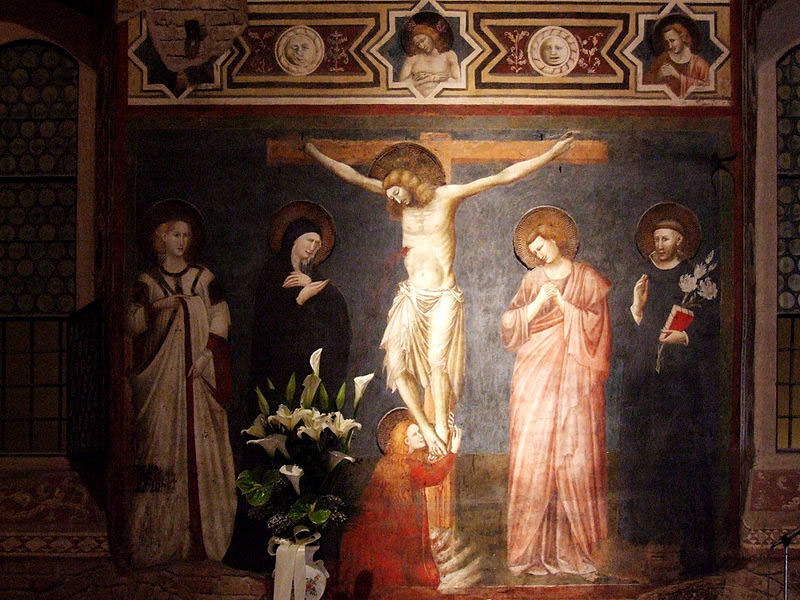The city of Tolentino, little known to most, is located in the Marche hinterland, in that area not yet mountainous but still far from the coast. Among the treasures of this town is the splendid Basilica of St. Nicholas, built between the 13th and 14th centuries and modified in various parts throughout history. The Basilica was named after St. Nicholas only in 1476: previously the title was to St. George. We find traces of this alternation in the marble portal made by Nanni di Bartolo between 1540 and 1550: above the lunette framing the Virgin and Child with St. Nicholas and St. Augustine, we find the depiction of St. George intent on slaying the dragon.
 |
| The Façade of the Basilica of St. Nicholas of Tolentino. Photo released by the author in the public domain |
 |
| The lunette in the facade. Photo released by the author in the public domain |
Once inside, one is immersed in the Baroque decorations of the only nave that makes up the basilica: the layout is the original one dating back to the 13th century, but the decoration was completely changed in the 17th century. The various side chapels were gradually commissioned, the basilica was covered with precious marbles, and finally, between 1605 and 1628, the wooden coffered ceiling that was to replace the original truss ceiling was made by Filippo da Firenze, a master carver. The ceiling, made of wood painted with pure gold, illuminates the entire nave from the entrance to the altar.
 |
| Interior of the Basilica of St. Nicholas of Tolentino. Photo released by the author in the public domain |
The most fascinating part of this architectural complex (at least in the opinion of yours truly) is probably the chapel known as the Cappellone di San Nicola. Entering this rectangular room after visiting the rest of the Basilica, one feels a kind of calm: the gilded stuccoes are gone and a geometric regularity greets us. The large chapel is completely frescoed, from the ribs of the vault to the sails, to the walls: the color of the background, a deep blue, characterizes the entire room, reminding us of the ambience of Giotto’s Scrovegni Chapel. Looking up, in each sail we find, seated at their own table full of open volumes, the four Evangelists, each paired with one of the Doctors of the Church. The walls are divided into orders where the stories of Our Lady , the stories of the life of Jesus and, finally, the stories of St. Nicholas of Tolentino are told. The various orders are separated from each other by decorative fascicles from which peep half-length portraits of saints and angels. The entire cycle culminates in the crucifixion of Christ, which coincides with a small marble altar set below the painted scene.
 |
| The Chapel of Saint Nicholas . Photo released by the author in the public domain |
If at first it was thought that these frescoes were made after 1325, the year in which the process of canonization of the saint began, they are now dated to the first twenty years of the fourteenth century: in fact, canonization was suspended for a long period of time (sanctification took place in 1446) and it seems strange that this decoration was made at a time of doubt about the sainthood of the personage. More probable, according to many, is that it was made after the saint’s death in 1305, thanks to the enthusiasm aroused by the miracles that were beginning to be attributed to him; among these is the Miracle of the Ship depicted with great skill and dynamism on the walls of the Cappellone. Giottesque memory resurfaces especially in some of the panels where we see, for example, figures placed from behind that should give dynamism to the composition, or circular elements stretched in an effort to render the three-dimensionality of space.
 |
| The Chapel of Saint Nicholas: the Crucifixion. Photo released by the author in the public domain |
 |
| The Chapel of St. Nicholas: the Miracle of the Ship. Photo released by the author in the public domain |
The entire cycle was attributed to the Rimini school as early as 1905: in particular, it is very evident that the whole thing was designed by a single mind and then carried out by a large number of collaborators, namely a workshop. The quality of the frescoes varies greatly: from very high peaks one arrives, especially in the lowest order depicting scenes from the life of St. Nicholas, to low quality scenes created by less experienced collaborators. After the recent restoration lattribution has been more confidently directed toward the workshop of Pietro da Rimini. Tradition, on the other hand, still attributes the cycle to an unspecified Master from Tolentino.
Once you have satiated your eyes with the brilliant colors of this place, from a side door of the chapel you can exit onto the cloister to enjoy one last taste of monastic tranquility with the frescoes of the large chapel still firmly etched in your memory.
 |
| The cloister. Photo released by the author in the public domain |
Warning: the translation into English of the original Italian article was created using automatic tools. We undertake to review all articles, but we do not guarantee the total absence of inaccuracies in the translation due to the program. You can find the original by clicking on the ITA button. If you find any mistake,please contact us.